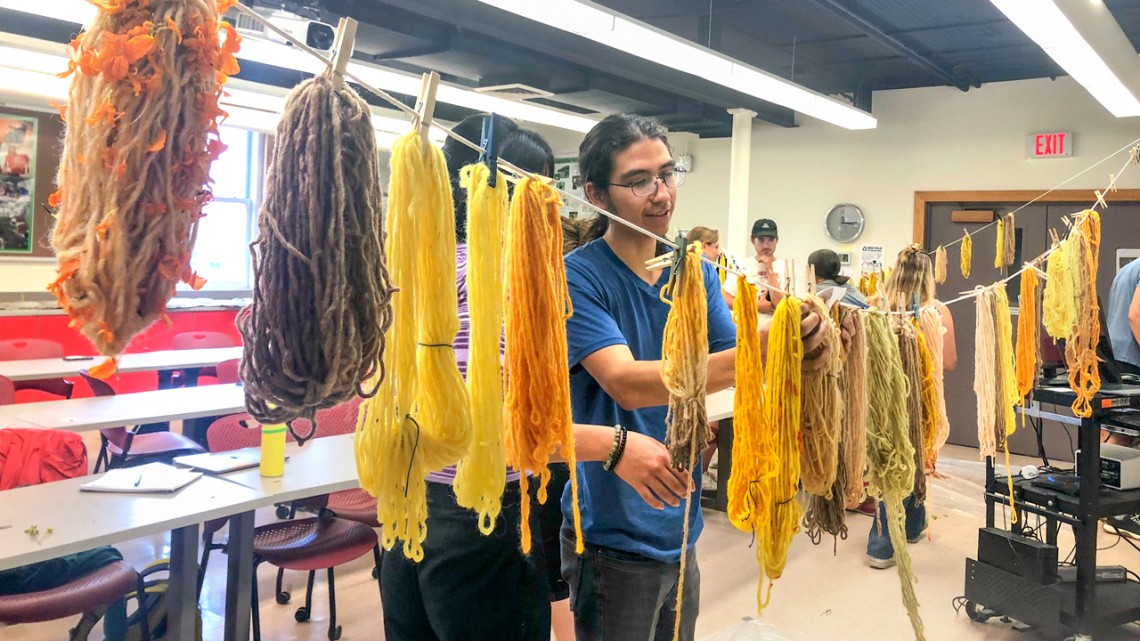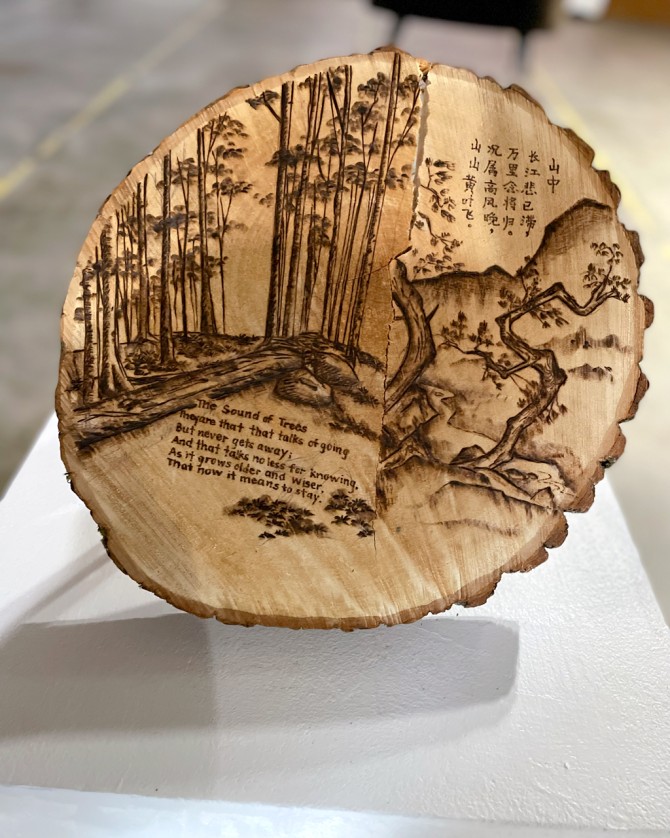
As part of the Earth Projects class, Sam Jurado ’24 hangs naturally dyed yarn to dry.
Field-based art class boosts green consciousness
By Blaine Friedlander, Cornell Chronicle
For environmental science students, making art with natural objects brings ecology into focus.
Instead of meeting in a formal classroom, students taking Earth Projects are examining the natural world immersed in the landscape outdoors during multi-day field trips and crafting art based on their experiences.
“Through these trips, I’m perceiving and understanding the landscape,” said Claire Hu ’25, who created a poetic English and Chinese leitmotif burnt into a slice from a tree cut long ago.
The group spent a weekend at Cornell’s Biological Field Station at Shackelton Point on Oneida Lake, north of Syracuse, New York. They camped at the university’s Arnot Teaching and Research Forest in Schuyler County, New York. And they’ve explored the Cornell Experimental Ponds in Lansing, New York.
The students unveiled their art at an exhibition held at Ithaca’s Soil Factory Oct. 5, illustrating how they grasped surroundings, scooped soil into their hands to make paintings and celebrated nature with their imaginations.
Anna Davidson, a senior researcher and lecturer in Department of Natural Resources and the Environment in the College of Agriculture and Life Sciences (CALS), teaches the experiential field course, offered through CALS. She is an Einhorn Center for Community Engagement faculty fellow.
“Earth Projects is a place-based class to discover ecology and landscapes through multiple artistic approaches using writing, drawing, performance, sculpture, video and sound,” Davidson said. “It’s important to take in our environment through different avenues. The idea is to appreciate and immerse yourself in it.”
Davidson herself balances a world between art and science; she holds an MFA in visual arts and a doctorate in plant science, both from the University of California, Davis.
The exhibit included Hu’s piece, which employs Robert Frost’s poem “The Sound of Trees” and Wang Bo’s “In the Mountains,” a Chinese poem from the 7th century. The woodcut has undertones of longing and immobility but invites people to ponder the influence of cultural narratives while examining humanity’s relationship with nature.
For the exhibit, the students installed a tree featuring hanging hoops woven with naturally dyed yarn, created after a visit to Miller Creek Farm in Spencer, New York, where farm owner Linda McCandless ’74 helped the students to use yarn spun from the wool of her Horned Dorset sheep.
Local artist Margaret Davidson later taught the students how to dye the wool with natural materials like golden rod, tea, onion skins and walnuts, and then how to create artistic weavings.
Inspired by local artist Kirsten Kurtz, manager of the Soil Health Lab in the School of Integrative Plant Science Soil and Crop Sciences Section (CALS), the students working in teams created large canvas “soil paintings” portraying tree cross sections to illustrate climate change through the lifespan of ash, fir, maple and hemlock. They linked annual climate data to different paint colors and added sound to the paintings as well.
One team – Daniel Dixon ’24, Ellen Berghausen ’25, Lily Heslam ’26, Ingrid Comella ’23 and Hu – noted that New York state’s ash trees not only provide forest habitats but also have been used commercially for furniture and baseball bats. Ash is disappearing due to an emerald ash borer invasion.
And the class learned about Indigenous cultural traditions in the Finger Lakes region. “This class was eye-opening just in terms of the ways of seeing, especially during our visit to the Oneida Cultural Center,” said Ty Oshima ’26. At the center, the students learned about the history and art of the Oneida Nation from linguist Chelsea Jocko and artist Jen Wilt. That experience culminated in the students’ creation of artistic video and sound pieces.
“I was intrigued by the different concepts of life and death, as viewed by the Oneida,” Oshima said, “especially their views on animals and sustainability.”
Added Janilia Etienne ’25: “I also learned about myself and like how to express environmental notions – using art as a medium to express how we feel about climate change.”
As an environmental science major, Gianna Klein ’25 said the class fell outside her comfort zone. “I’m not an artist, but that’s why I liked the class,” she said. “Everything is fast paced at school. Here, we got to slow down in the moment and do art, which was fun. There was a lot of human connection with my peers, which sometimes I don’t get in other classes. It was fascinating.”
The class demonstrates that art can play a role in a field course said Davidson, a Cornell Atkinson Center for Sustainability faculty fellow, who hopes it shows how cultural and artistic practices deepen a sense of place. “Art can lead to empathy for the environment,” she said. “Ultimately this leads to greater environmental consciousness and stewardship.”
Media Contact
Get Cornell news delivered right to your inbox.
Subscribe

